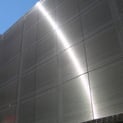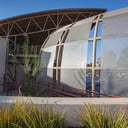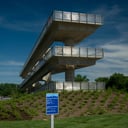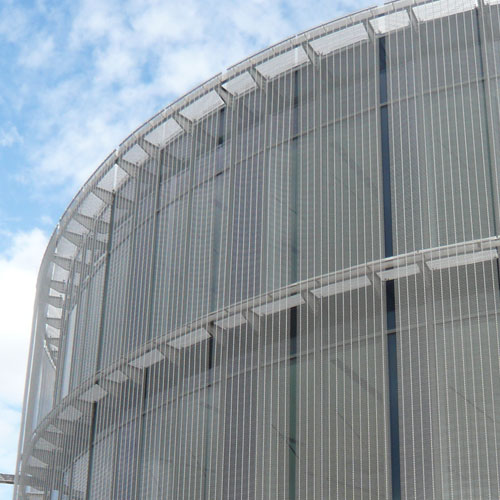Pros and Cons of Architectural Mesh For Exterior Applications
In the world of architectural design, architects must sift through the countless design materials available to deliver an innovative design. Architectural mesh, for example, is a new material that architects can use to provide the outside of a structure with a one-of-a-kind aesthetic.
From sunlight protection to natural ventilation, architectural mesh provides the customization needed to turn your vision into a reality. But how exactly can you use it for exterior applications?
For over 20 years, W.S. Tyler has been at the forefront of integrating architectural mesh into the world of architecture.
In this article, we will establish the pros and cons of using architectural mesh for facades, canopies, infill panels, and free form projects.
Pros and Cons of Using Architectural Mesh Façade
 Pros
Pros
The most beneficial quality architectural mesh provides facades is the variety of mesh types. With over X mesh profiles to choose from, there is a solution that can provide everything you need to make your vision a reality.
Architectural mesh is also a great way to create natural ventilation. This is particularly useful when applying a façade to a parking structure that requires a certain amount of ventilation to follow city ordinances.
This is adjustable by customizing the openings of the mesh.
Sun protection is also achievable when architectural mesh gets used to construct exterior facades. By filtering the amount of sunlight that hits the structure, the temperature within the structure is more controlled.
As a result, expenses associated with air conditioning get reduced.
The versatility of architectural mesh allows it to serve as a retrofit. This means that if a structure already exists, mesh can get placed on top of it.
The life-cycle of architectural mesh is another key element to consider when selecting the material for an exterior façade. Architectural mesh is a durable material that lasts the lifetime of the structure with little to no maintenance required.
As it is weather-resistant, architectural mesh is suitable in most environments where the architect wants to create a heightened aesthetic.
Cons
Implementing an architectural mesh façade requires a significant amount of tension to prevent it from moving. That said, architectural mesh facades are limited to structures that are strong enough to handle the force created by the tensioning system.
The cost of architectural mesh is another element that can drive architects towards other design material, such as perforated plates.
When it comes to the cost of mesh material used for a project, there are several factors at play. Of these factors, fabrication tends to have the biggest impact.
This is particularly true for custom applications. In other words, the more customization needed the higher the cost.
Pros and Cons of Using Architectural Mesh In Canopies
 Pros
Pros
Architectural mesh, when applied to exterior canopies, provides a large amount of climate control. While architectural mesh provides a unique aesthetic to canopies, it also provides enough shade to reduce temperatures during summer while retaining heat during the winter.
While it provides excellent shading, architectural mesh canopies are a transparent product. This allows visitors to view the surrounding area from the inside out, providing a unique experience.
Architectural mesh canopies are perfect for sunny areas that don't see much rain.
Cons
The biggest drawback associated with architectural mesh canopies is that it doesn't block precipitation. As it is an open product, rain and snow can make its way through the openings in the mesh.
Pros and Cons of Using Architectural Mesh Infill panels
 Pros
Pros
Architectural mesh infill panels can get customized to fit most railing systems. That said, if a railing system is already in place architectural mesh panels can cut to fit the grid.
DOKA-MON0 1591, for example, can be manipulated by hand to fit a railing system that's angled for a stairwell. This reduces the amount of excess material that is wasted.
Also, because it’s stainless steel, architectural mesh is durable. This is particularly beneficial when subjected to high volumes of traffic.
With that, exterior infill panels are ideal for entranceways and transportation structures.
Cons
The biggest drawback of an infill panel mesh system is that it can be expensive. As stainless steel mesh should not touch other alloy types, you will need to buy stainless steel framing.
This is on top of the $80 to $90 per square foot price tag of the mesh.
Also, there are a lot of contractors that are not familiar with architectural mesh. If the contractor installing the mesh mishandles the mesh, it will get damaged and not portray the desired atmosphere.
Pros and Cons of Using Free Form Architectural Mesh
 Pros
Pros
Although architectural mesh is a stainless steel product, it is flexible. This allows it to get formed while maintaining the integrity of its structure.
This characteristic is particularly useful when forming sculptures around an existing structure. With that, architectural mesh can also be free-formed to protect sculptures from damage.
Free form architectural mesh is ideal for any area that needs an enhanced atmosphere and protection.
Cons
While stainless steel mesh is flexible, it is not as flexible as other materials, such as fabrics. That said, applications that call for materiel to take on a form with a tight radius can be difficult to achieve when working with architectural mesh.
In other words, you can only work within the flexibility of the mesh profile you choose.
Ensure Your Next Project Has A Polished Exterior
Architectural mesh provides architects with a means of creating a unique look. Even when applied to the exterior of a structure, it will stand the test of time and last as long as the structure.
Mesh provides the customization, sunlight protection, fall protection, natural ventilation that most exterior projects call for. That said, the contractor you select to install is vital.
This is because architectural mesh must be handled with care regardless of the application.
With over 20 years of experience working with architectural design, W.S. Tyler strives to help architects integrate architectural mesh into their projects.
For an in-depth breakdown of the ideal installation contractor, refer to our article: How to Select an Architectural Mesh Contractor (Process and Cost).
About Ronnie Brown
Ronnie is the Content Writer for W.S. Tyler and has four years of experience as a professional writer. He strives to expand his knowledge on all things particle analysis and woven wire mesh to leverage his exceptional writing and graphic design skills, creating a one-of-a-kind experience for customers.




